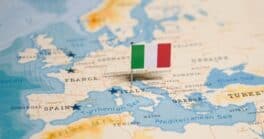GCC banks are expanding their footprint in Asia-Pacific, now the Gulf’s number-one trade partner.

While Western economies struggle with the aftermath of the Covid-19 pandemic and the ongoing war in Ukraine, the International Monetary Fund predicts that Asia-Pacific will supply 70% of global economic growth in 2023, with China and India accounting for over half of activity.
For Arab banks looking to expand their footprint beyond the Middle East, this presents an opportunity to build up the small networks they started to craft in the region in the late 1970s as a way to diversify their portfolios.
“Most of the expansion in [East] Asia happened in the form of representative offices or branches in developed markets, giving banks access to the syndication markets or helping them to capitalize on the bilateral economic relations with their home countries,” says Mohamed Damak, senior director and head of Islamic finance at S&P Global Ratings.
Arab banks usually started by setting up a small operation in a globally recognized financial hub, such as Singapore or Hong Kong, using it as a gateway or testing ground for investments in wider Asia.
“Through our international businesses, we aim to diversify our revenue, earnings and risks,” says Abdulla Mubarak Al-Khalifa, group CEO of Qatar National Bank. The Middle East’s biggest lender, with over $320 billion in assets, QNB set up its first branch in Singapore in 2008. It later opened a branch in India along with representative offices in China and Vietnam. The latest addition to the network was a branch in Hong Kong in 2021.
“We chose markets that demonstrated strong macroeconomic and banking sector growth fundamentals in the long term,” says Al-Khalifa. “Within Asia, we are specifically targeting the ASEAN economies.” These export-oriented economies have exceeded global economic growth over the past two decades and are expected to continue, he notes, driven by trade opportunities, direct investments, large infrastructure spending opportunities and populations that are “young, growing, urbanizing and increasingly educated and middle class.”
Trade Ties Multiply
The Middle East has become a prime destination for Asian exports and investments, and the traffic is moving in the opposite direction as well. Gulf Cooperation Council (GCC) states sell oil and gas to countries like China, India and South Korea, where demand is expected to continue growing despite price fluctuations, but the trade relationship now goes well beyond that.
“The pivot of the Middle East’s international trade toward Asia has been ongoing for decades,” says Theresa Batshon, senior vice president and area head for Asia Pacific at Jordan’s Arab Bank, citing factors including new free-trade agreements that are expected to further energize growth. Asian investments in MENA’s oil industry are strategic, and economic diversification in the Middle East is opening new sectors to Asian investment.
“As MENA oil producers transition away from fossil fuels, cooperation in this sector may gradually be replaced by investment in sustainability, renewables and developing alternative energy sources such as hydrogen and solar,” adds Batshon, whose employer is one of MENA’s main lenders and a presence in Singapore, China, Australia and South Korea as well.
GCC banks are stepping in to facilitate trade expansion between the Middle East and Asia-Pacific, offering a range of corporate and investment banking services.
“Our goal is to position ourselves as the go-to institution for Asian companies looking to trade with, or invest in, the Middle East” says Ahmed Abdelaal, group CEO of Bank Mashreq, a leading United Arab Emirates bank that operates in five Asian countries, with a regional office in Hong Kong.
The Gulf’s strategic shift toward Asia took a new turn after the pandemic. In 2021, GCC-China trade volumes reached $180 billion, more than the Gulf states’ total trade with the US and Europe combined. In December, Chinese President Xi Jinping’s visit to Saudi Arabia, punctuated by a $50 billion investment pledge to the kingdom, was another significant milestone, building on an already expanding and diversifying presence.
In recent years, Chinese investment in the GCC has evolved from mainly energy and infrastructure to include the finance, logistics, data centers, health care, mining, retail and tourism sectors. The biggest deals involve Chinese giants like Huawei, Alibaba and Tencent, but thousands of smaller companies are also stepping in. According to a recent survey by the Shanghai Institute of International Studies and PWC China, 82% of Chinese firms intend to expand their MENA presence in the coming three to five years, with 37% indicating they already have detailed business plans.
“Our branch in Hong Kong is experiencing a surge in the number of conglomerates from Greater China establishing regional offices in the UAE,” says Abdelaal. “We are eager to cater to their diverse needs across regional cash management, investment banking, treasury and capital markets.” In 2021, Mashreq opened a representative office in Shanghai to strengthen its footprint in China while simultaneously launching corporate and global transaction banking platforms from its Hong Kong branch.
At present, the vast majority of Chinese companies operating in the Middle East are concentrated in the UAE, but they are increasingly looking to expand into Saudi Arabia, Kuwait, Bahrain, Oman and Qatar. Investors have cited “high market potential” and “strong customer purchasing power” as the main kures, according to Arabian Gulf Business Insight.
Leveraging Expatriate Communities
Gulf countries are also stepping up their game in the Indian subcontinent, opening another door for their banks. Last year, India and the UAE signed an agreement to lower tariffs and increase non-oil trade from $60 billion in 2022 to over $100 billion by 2027. A regional trade deal with all six GCC nations is also under discussion, as well as a $5 billion undersea pipeline linking the Arabian Peninsula to Gujarat.
“India, with its robust domestic consumption and export-oriented manufacturing ecosystem, is fast emerging as an economic superpower,” says Abdelaal. Bank Mashreq’s presence their dates from 1980, but it is planning “a significant move” this year, he adds.
Dubai-based Emirates NBD opened new branches in Gurugram and Chennai last year to complement the Mumbai offices it opened five years prior. “Our new strategically located branches will offer improved geographical coverage,” Shayne Nelson, Emirates NBD’s group CEO, said in a press release, “allowing us to cater to both the northern and southern markets of India, thus enabling ease of banking including smoother trade financing and fund and non-fund-based facilities for customers.”
For Dubai’s biggest bank, a larger presence in India also means taking a fresh look at the GCC market, where tens of millions of migrant workers from Asia currently live. Indian expatriates alone make up a third of Emirates NBD’s client base; in 2022, the bank reports that it facilitated $2 billion worth of remittances to India through its specially designed online corridor, DirectRemit.
Expatriates are also a target for Mashreq Bank, which opened in Pakistan in 1978, India in 1980, Bangladesh in 2001, and Nepal in 2010: that countries provide the bulk of the GCC’s workforce. Late last year, Mashreq signed a deal with Bank al-Habib, a leading Karachi-based lender, to provide remittance transfers free of charge. The GCC is home to the world’s largest expat community from Pakistan. In May, migrants sent home over $1 billion, the State Bank of Pakistan reported. Earlier this year, Mashreq also received regulatory approval to establish a fully fledged digital bank in Pakistan.
“We are excited about growth opportunities,” says Abdelaal. “This allows us to support investments in digitizing ecosystems across retail, small and medium-size enterprises, agriculture and the payments landscape.”
The UK-based think tank Asia House expects remittance totals to reach $578 billion annually by 2030, which it describes as a “fundamental global shift” that will impact international politics, business and finance.
For the Gulf states, which are all monarchies or local equivalents, strengthening business relations with Asian countries also comes with the political advantage that Asian governments generally are less likely to bring democracy or human rights issues to the negotiating table. In April, China even acted as an unexpected peacemaker between Saudi Arabia and Iran.
Earlier this year, the kingdom was reportedly in talks to join the New Development Bank, the Shanghai-based lender often called “the BRICs bank” that China midwifed in 2015 as an alternative to Western multilateral institutions. The UAE has already been a member for two years. In April, the Asia Infrastructure Investment Bank, another multilateral based in China, announced it will open its first overseas office in Abu Dhabi to finance projects in the “global south.”
At least for the coming few years, the economic lure of Asia-Pacific appears set to deepen for its neighbors to the west.



